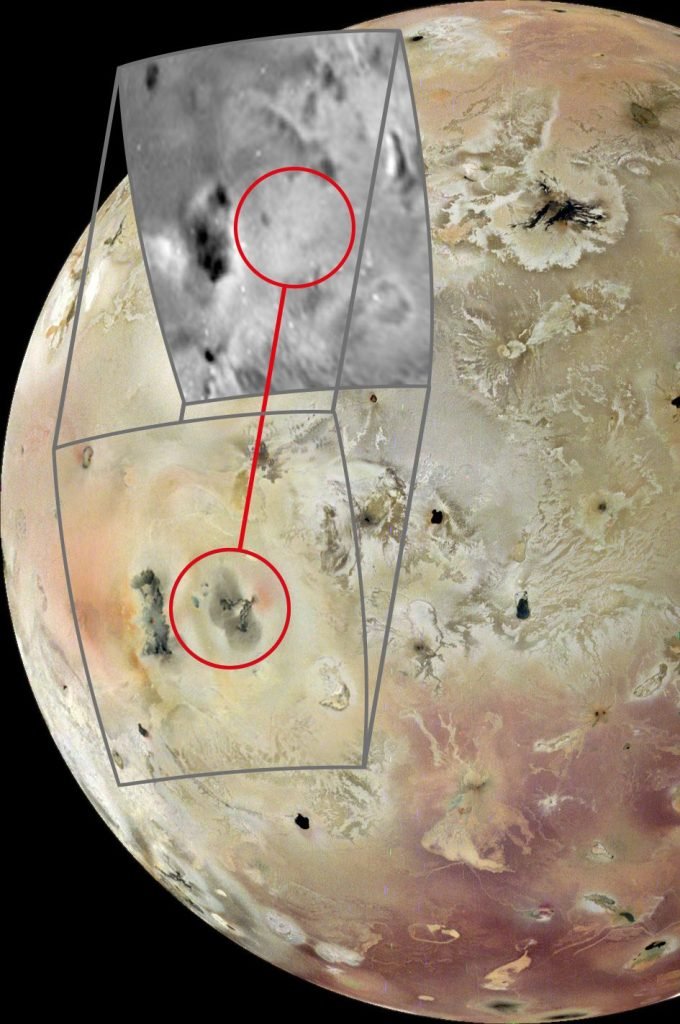NASA’s Juno spacecraft has made a groundbreaking discovery on Jupiter’s moon Io, capturing images of a massive new volcano. Io is renowned as the most volcanic entity in our Solar System, boasting over 400 active volcanoes. The revelation came through detailed analysis of close-up images taken by JunoCam, the spacecraft’s onboard camera, during a flyby on February 3, 2024.
The new volcanic feature, which appeared south of Io’s equator, was not present in the images captured by NASA’s Galileo spacecraft during its mission in November 1997. This dramatic change underscores Io’s fiery nature and how its surface can be significantly reshaped within just a couple of decades.
Michael Ravine, Advanced Projects Manager at Malin Space Science Systems, explained the importance of the discovery: “Our recent JunoCam images show many changes on Io, including this large, complicated volcanic feature that appears to have formed from nothing since 1997.” The newly identified volcano is close to an existing volcano called Kanehekili and spans an area of about 180 kilometers.

JunoCam’s images from February 2024 illuminated Io under the reflection of sunlight from Jupiter, giving scientists a clear and valuable view of the volcanic surface. Compared side by side with the previous Galileo images, the new volcanic activity is unmistakable. The recent images not only show the new volcano but also highlight extensive lava flows and volcanic deposits.
Interestingly, Io’s volcanic activity is driven by tidal heating from Jupiter. The gravitational pull from the massive planet, along with additional tugs from neighboring moons Europa and Ganymede, generates significant frictional heat within Io’s core. Unlike its neighboring oceanic moons, which maintain subsurface oceans due to this heat, Io’s internal heat causes magma to surface, leading to frequent volcanic eruptions.
JunoCam’s flybys have provided unprecedented views and insights, capturing the new volcano from a distance of about 2,530 kilometers, with each pixel representing approximately 1.7 kilometers. The area’s surface appears young, devoid of impact craters, which indicates active and continuous reshaping by volcanic processes.
This discovery also raises new questions about Io’s volcanic history and interior composition. Scientists are eager to better understand the moon’s internal heat distribution and the mechanisms that trigger different types of eruptions. Observations like these are essential for unraveling the mysteries of Io’s interior and its geological evolution.
Juno’s mission continues to extend our knowledge boundaries despite its primary mission concluding in 2021. The spacecraft is now in its extended mission phase, conducting additional flybys of Io until 2025. However, these encounters will occur at increasing distances, limiting the detail of future observations.
In addition to its scientific contributions, JunoCam serves a broader purpose by providing high-quality images accessible to the public. This enhances interest and offers a gateway for enthusiasts and researchers alike to delve into the intriguing phenomena of our Solar System.
Juno’s detection of a new volcano on Io not only highlights the moon’s dynamic nature but also contributes valuable data that could help scientists understand similar processes on rocky planets. While many questions remain about Io, each observation brings us one step closer to understanding the complex interplay of forces shaping this fascinating moon.
